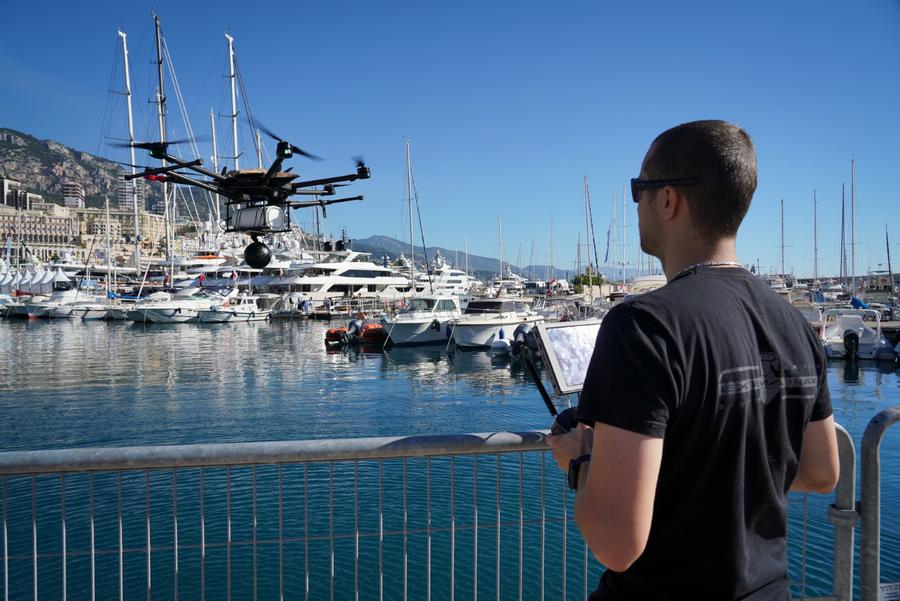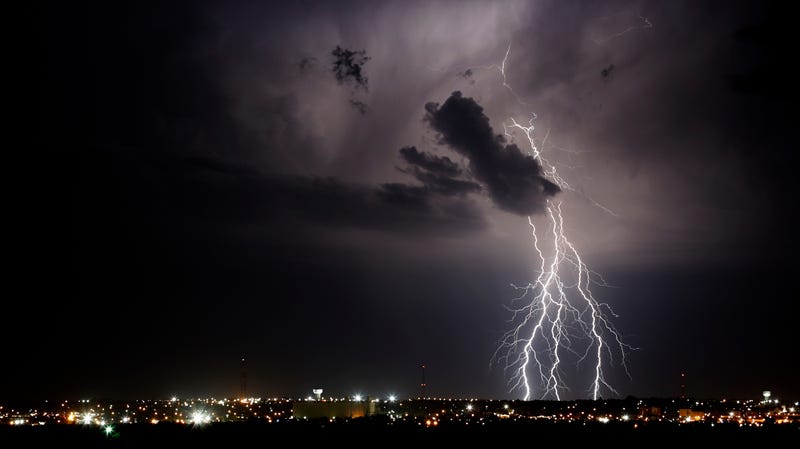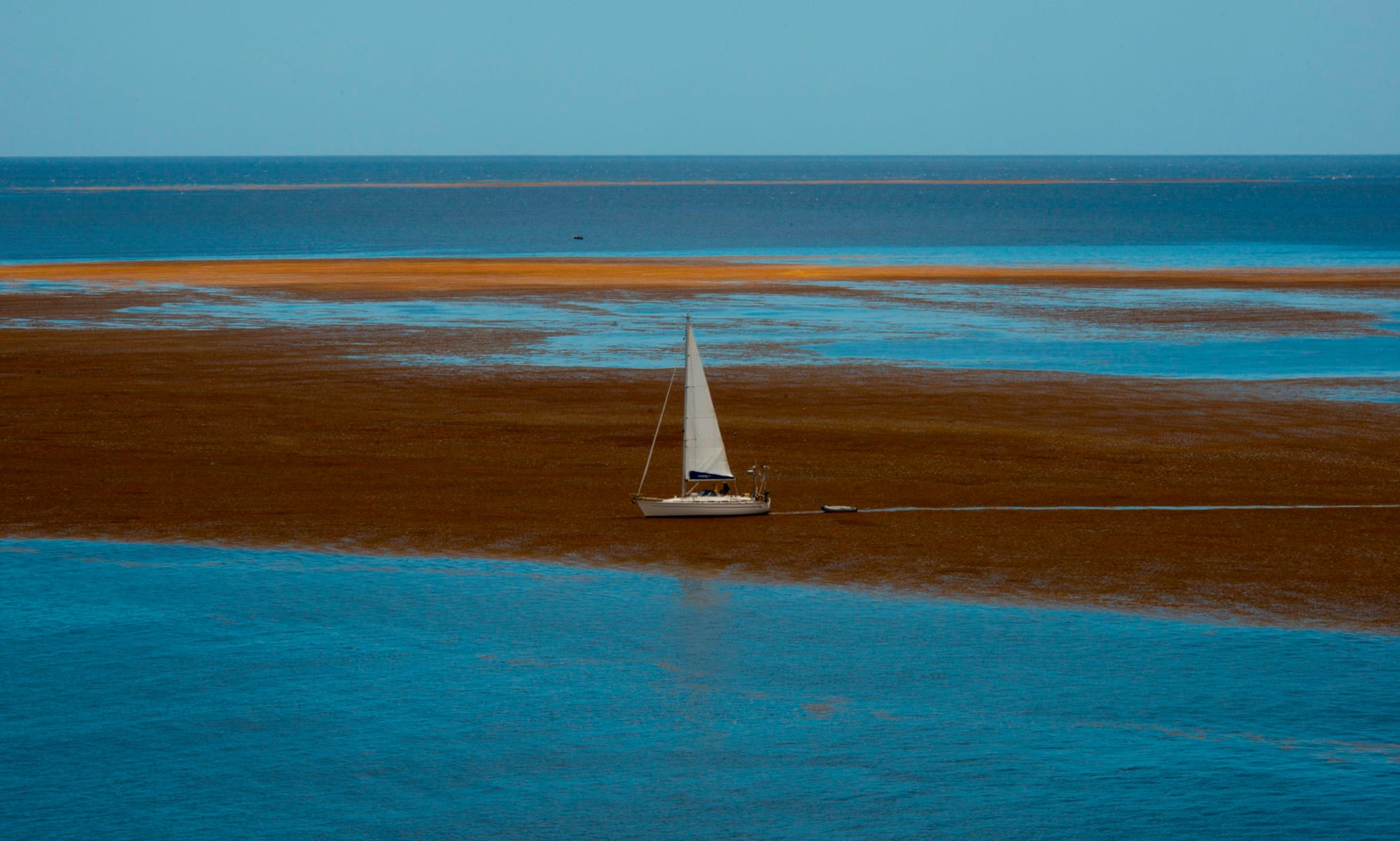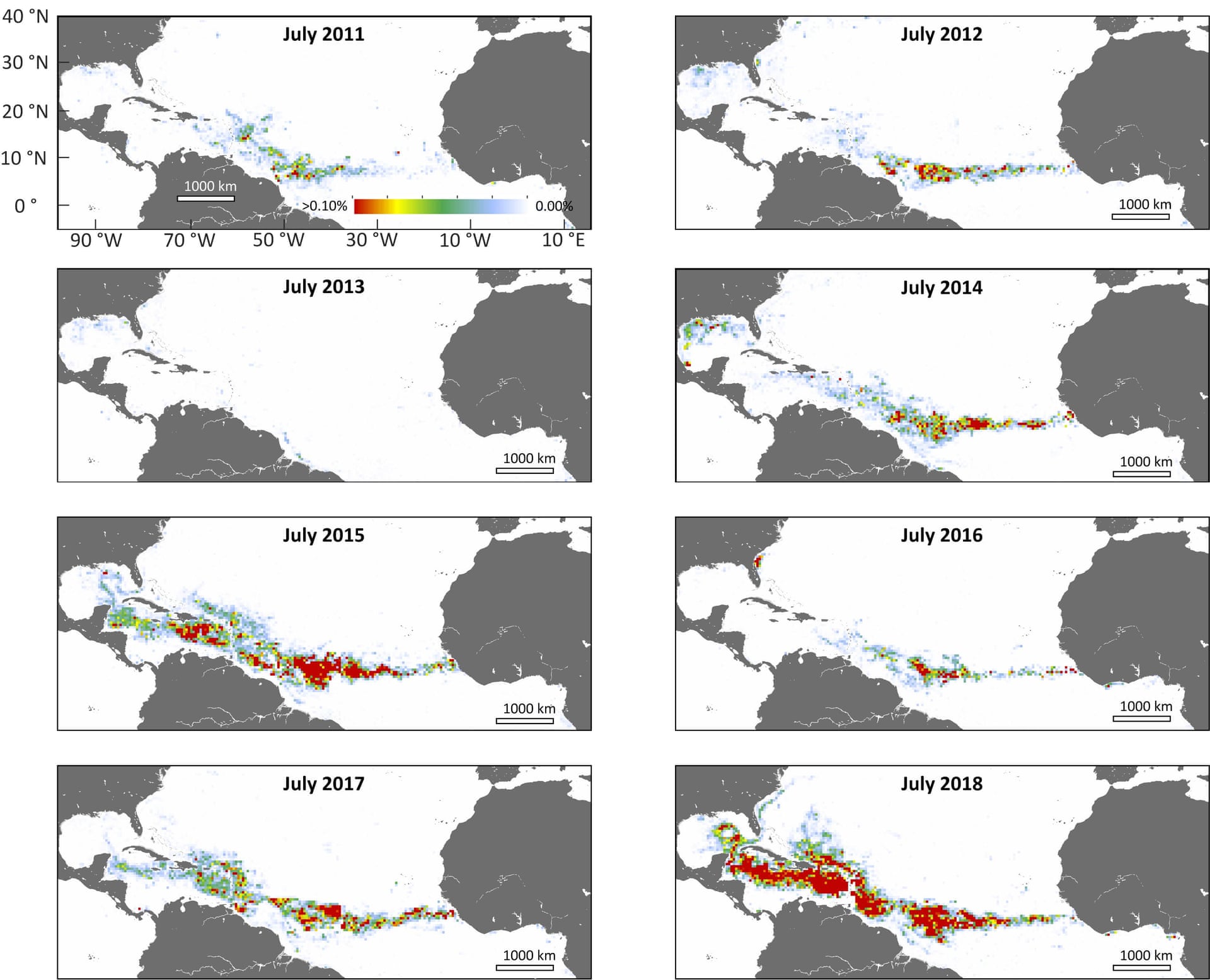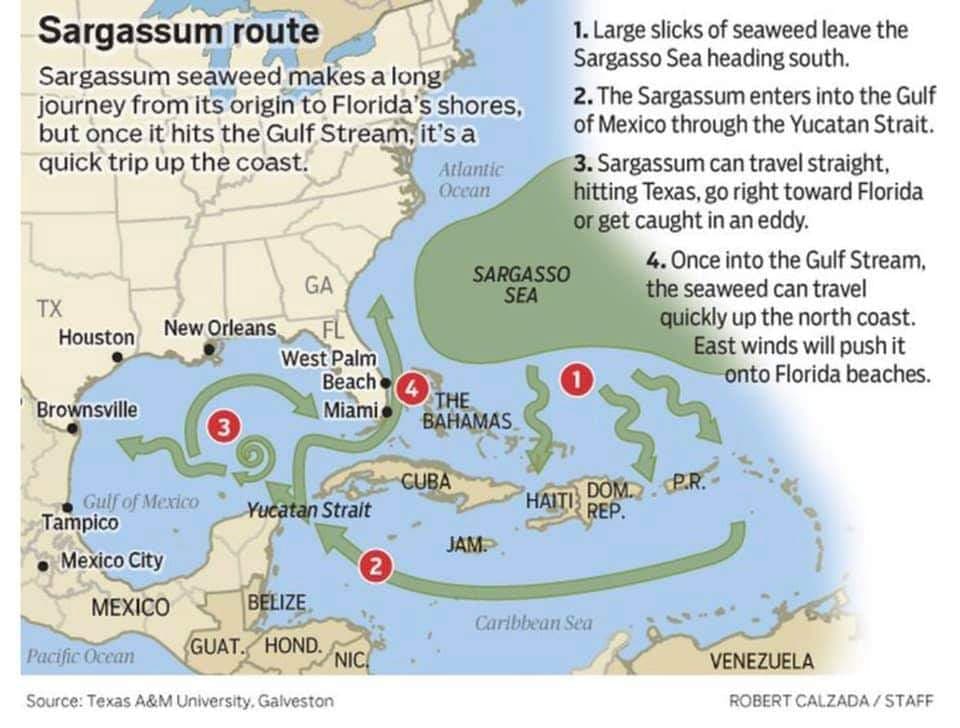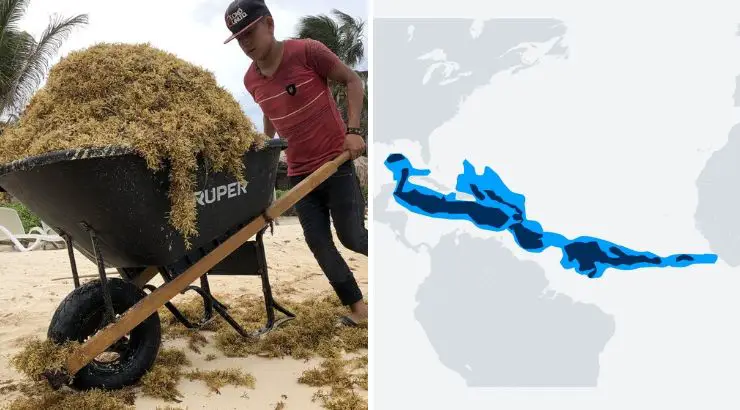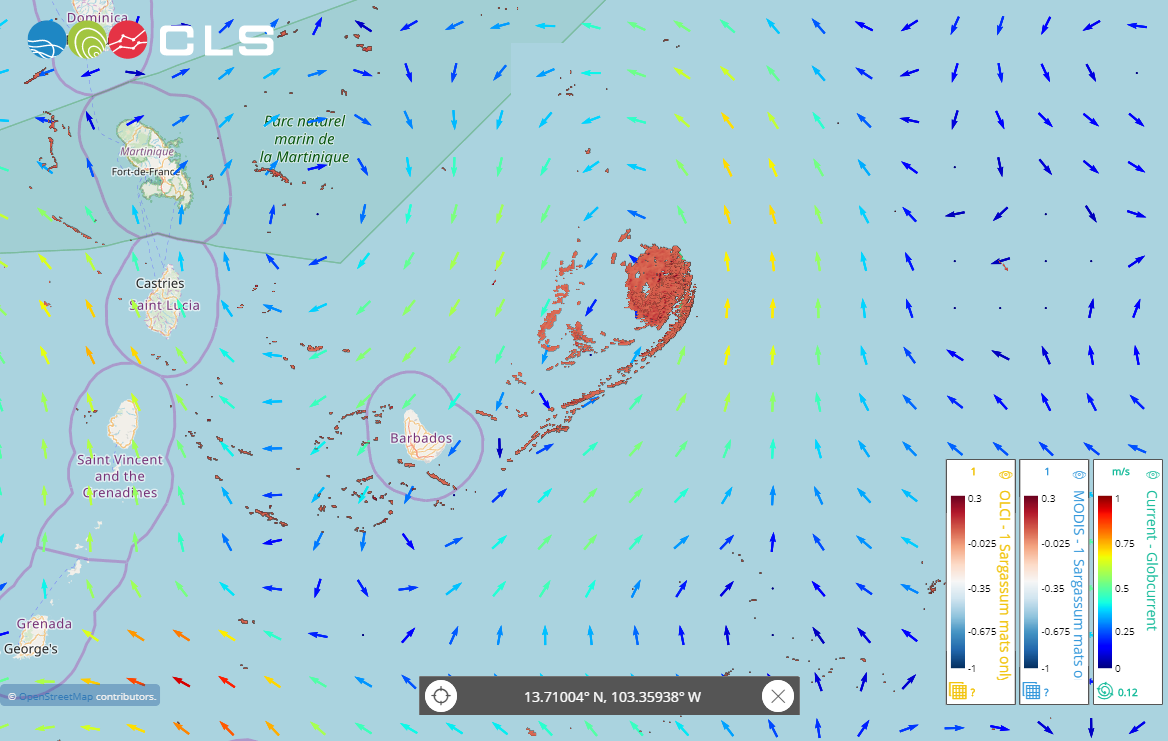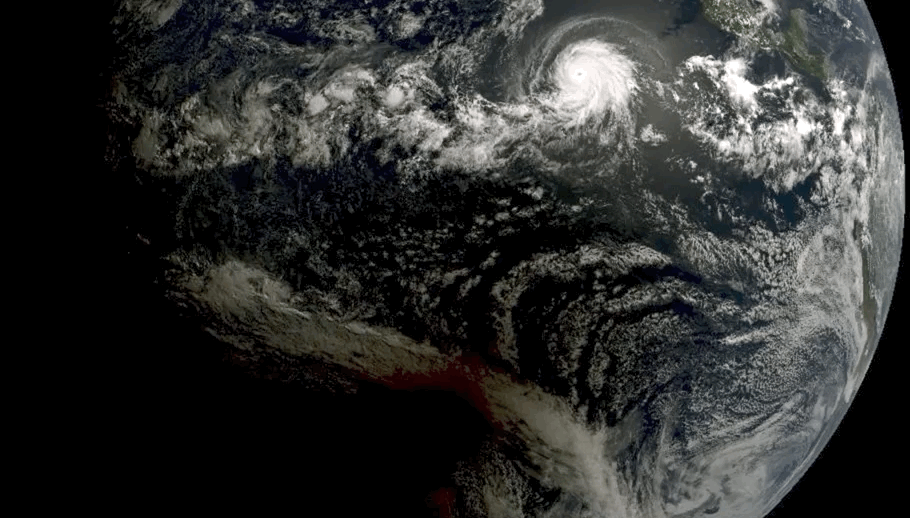Sargassum algae piles up along Mexico's Punta Piedra beach.
Reuters
From The Atlantic by Ed Yong
Since 2011, blooms of Sargassum have wreaked havoc on tropical shores.
A new study explains why this is likely a new normal.
In 2018, as seaweed piled up on beaches throughout the Caribbean, it began to rot.
Already stinking and sulfurous, the thick layers began to attract insects and repel tourists.
The seaweed—a type of brown algae called sargassum—had grown in the ocean and washed ashore in unprecedented quantities.
It prevented fishers from getting into the water, and entangled their nets and propellers.
It entangled sea turtles and dolphins, too, fatally preventing them from surfacing for air.
It died and sank offshore, smothering seagrass meadows and coral reefs.
Barbados declared a national emergency.
Sargassum seaweed off the coast of Guadeloupe.
Photograph: Helene Valenzuela/AFP
In normal years, sargassum is a blessing rather than a curse.
Mats of it drift around the ocean, held afloat by gas-filled bladders that look like grapes.
They accumulate in the North Atlantic,
forming the Sargasso Sea—a region that the explorer Sylvia Earle has described as a “
golden floating rainforest.” The fronds are a breeding site for American eels, a sanctuary for turtle hatchlings, and a haven for hundreds of other species, some of which live nowhere else.
The Sargassum fish, for example, is a small, frog-faced predator whose body has adapted to perfectly mimic the seaweed.
The Caribbean would usually experience a few small mats of sargassum washing ashore in a given year, until 2011, when the seaweed first began arriving in unexpectedly large waves.
Similar pileups have occurred almost every year since;
2015 and 2018 saw especially bad blooms.
Some countries have set up nets to block the incoming algae, or hired people to clear affected beaches with
rakes and backhoes.
And still the sargassum comes.
Nasa’s satellite data confirms that the record-breaking seaweed belt forms in the summer months, with 2015 and 2018 having the biggest blooms.
Photograph: USF College of Marine Science
The seaweed does have one very convenient trait: The chlorophyll pigment within it reflects infrared light more strongly than the surrounding seawater does.
To
satellites that detect infrared, sargassum blazes like a bonfire.
Six years ago, Jim Gower from Fisheries and Oceans Canada
used satellite images to show that the 2011 bloom had an unusual origin.
In April, sargassum had begun growing off the coast of Brazil and near the mouth of the Amazon River, in an area far south of its normal range.
By July, it had spread across the entire Atlantic.
Now Mengqiu Wang, from the University of South Florida, and her colleagues have shown that this ocean-spanning bloom, which they’ve dubbed the Great Atlantic Sargassum Belt, is now an annual feature.
By analyzing 19 years of satellite images, they showed that the belt first appeared in 2011, and has reappeared almost every summer since (except for 2013).
Last June, when the belt was at its thickest, it contained more than 22 million tons of seaweed, and stretched fully across the Atlantic’s waters, from the Gulf of Mexico to the western coast of Africa.
That figure is likely to be an underestimate: With a spatial resolution of one kilometer, the satellite data doesn’t capture small chunks of Sargassum.
“It highlights the most aggregated areas rather than describing the entirety of what is present,” says Deb Goodwin, an oceanographer at the Sea Education Association.
The Great Atlantic Sargassum Belt is a loose collection of seaweed scattered over a very large area, not a continuous bridge.
It’s also
not produced by the Sargasso Sea, which lies further north; Wang’s team confirmed that by simulating how particles of seaweed would move in the Atlantic’s currents.
They concluded that the belt likely develops from local patches of sargassum that occur naturally in the tropics.
But such patches have always existed.
Why have they only recently started to form sprawling blooms?
Wang’s team thinks that the new growth was connected to two factors on opposite sides of the Atlantic: the water discharged by the Amazon and upwelling currents rising off West Africa.
These two phenomena pump nutrients into the tropical Atlantic.
When they’re unusually strong, as they apparently were in 2009, they effectively flood the ocean with fertilizer, allowing sargassum to run amok.
But why, then, did the seaweed not bloom in 2010? Wang’s team thinks that it was delayed by low salinity (due to the influx of Amazon freshwater) and abnormally high temperatures—conditions that suppress the growth of sargassum.
Only in 2011, when temperatures returned to normal, could the seaweed make use of the influx of nutrients from previous years, and go wild.
And the bigger the blooms in the summer, the more likely they are to leave behind patches that survive through the winter.
If the conditions are right the following year, these “seed populations” can restart another bloom.
“Each successive bloom makes it difficult to imagine an end to this self-reinforcing cycle,” says
Amy Siuda, an ecologist and oceanographer at Eckerd College.
“This is likely the new normal.”
So, a quartet of factors—strong Amazon discharge, strong West African upwelling, moderate temperatures, and the presence of a seed population—could potentially explain the Sargassum Belt, including why it appears every summer, and why it was especially thick in 2015 and 2018.
But such factors “have impacted the central Atlantic Ocean for decades, if not centuries,” says Siuda “Why are we only seeing sargassum bloom in this region now? What tipped the balance? There is clearly still more to learn.”
Chuanmin Hu, who led the study, agrees.
“I have to emphasize that we have no direct evidence to prove any of this,” he says.
“These are our speculations, some educated and some hand-waving.”
They’ve been forced into that because many of the factors they identified aren’t regularly measured.
For example, they could only find data on the nutrients in the Amazon for two years: 2010 and 2018.
The latter levels were much higher, which might explain why sargassum blooms were so big that year.
Or it might not.
The river might have more nutrients due to increased fertilizer use, and stronger runoffs due to deforestation.
Or it might not.
“I don’t think there’s enough data,” Hu says.
“It takes a huge amount of money to go there and take measurements.”
A spectacular sargassum mat in an ocean eddy.
The new detection service by CLS_Group with ESA_EO Sentinel-3 satellite data and CMEMS_EU oceancurrents has tracked this mat since May 8 and can forecast its landing.
Of the four factors that the team identified, only sea surface temperatures are regularly measured.
And while many scientists have suggested that hot water could speed the growth of sargassum, “we found the opposite,” Hu says.
That’s not to say climate change is irrelevant, he cautions: Changing patterns of rain and wind could, for example, influence the strength of the West African upwelling.
Nor should the Caribbean count on rising temperatures to solve its sargassum woes, because the pace of change is likely too slow to make a difference in the near future.
Hu adds that other factors could be behind the rise of the Sargassum Belt, including nutrient-rich dust blowing in from the Sahara and changes in ocean currents.
And several aspects of the blooms still don’t make sense.
“If I were you, I would ask: If you have so much nitrogen and phosphorus, why do other [algae] in the ocean not grow as fast?” he says.
“I can’t answer that.”
Goodwin adds that “scientific understanding of Sargassum growth and bloom dynamics under natural, open ocean conditions is extremely limited,” since scientists have only addressed these questions in lab experiments.
And the sargassum itself is changing, too.
Siuda says that the recent blooms have included “a previously rare and genetically distinct form of sargassum” that comes from the south, differs from those in the Sargasso Sea, and harbors a slightly different community of organisms.
Sargassum Seaweed Bermuda June 2019
Little is known about this strain, or how the bloom is affecting the ecology around it, which makes it hard to predict how it will react to future conditions.
And since it likely evolved in relative isolation from its northerly relatives, its northward expansion suggests that “environmental conditions and ocean circulation patterns in the central Atlantic may have been shifting, undetected, for longer than the time interval examined by [Wang and her colleagues],” says Goodwin.
“A critical larger question emerges: What drove such an ecological transformation at unprecedented scale?”
In the absence of such knowledge, it is very hard to predict when and where future blooms will occur.
“Like hurricanes or nor’easters, we will likely be able to predict the severity of the upcoming season, but we won’t be able to predict exactly where the inundations will come ashore,” Siuda adds.
As Molwyn Joseph, Antigua’s environment minister,
said last summer, “We have made the assumption that this is going to be an annual thing, and the same way we prepare for hurricanes we have to prepare for Sargassum.”
Links :








